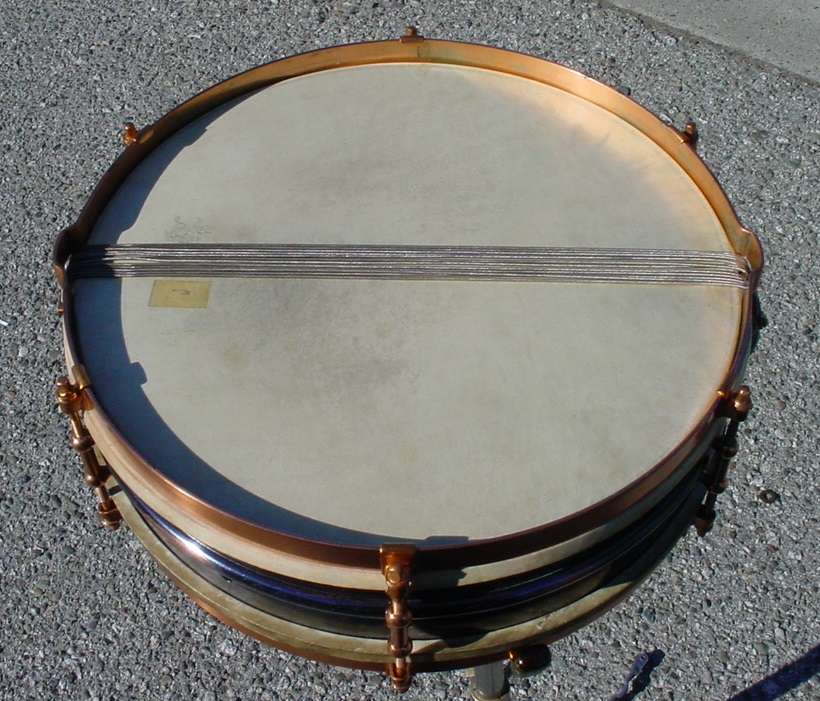Hi all,
Here’s another snare drum from the fertile waters of EBay.
Preliminary Thoughts:
Universal Model vs. Professional Model:
The L & L Universal Model appeared for the first time in the L & L 1924 catalog. The Universal shell was offered as a lighter weight, less expensive alternative to the heavier, 2-pc. brass shell Professional Model.
This shell is a 2-pc. brass shell with folded over and soldered back bearing edges but a lighter version as mentioned. The Universal rims are the “steel band” type rims vs. the nob single flanged rims found on the Professional Models. The top rim has the oval “Ludwig Universal Model” stamp. The Universal Model came with the top rim-mounted Tango Throw-Off Strainer (1922-53) and the P-84 “basket” butt plate vs. the P-338 strainer and P-85 butt plate that came with the Professional Models.
DeLuxe Finish:
As an alternative to the more expensive gold plating option L & L introduced the DeLuxe “simulated gold” Finish in the 1923 catalog. This finish was offered on the black nickel/scroll engraved Professional Model shells. The “simulated gold” finish is copper plated with some type of gold/amber lacquer.
So what we have here is a Universal Model snare drum with the DeLuxe Finish. It is generally understood that the DeLuxe Finish was only offered on the Professional Model shells but here we have another snare drum anomaly to ponder on. The most obvious and logical scenario is that this drum was “special ordered” with the DeLuxe Finish. I can hear WFL Sr. saying: “a sale is a sale, make the drum for the customer!” I did notice that this shell is nickel plated, copper plated and then black nickel plated. This is different from later DeLuxe/black nickel shells that have nickel plating under the black nickel plating. So was there an extra plating application in the early days of DeLuxe plating?
Thanks goes to Bill Wanser for helping me to date the drum and sort out all of the above information.
The SHELL:
The 4 x 14 shell is a 2-pc. shell with folded over and soldered back bearing edges but the lighter Universal version as mentioned above. The black nickel plaiting was in good shape and cleaned up well but as mentioned above, I noticed copper plating under the black nickel. I have never seen this on later 1920s- black nickel shells. Maybe this was how L & L prepared the shells for black nickel plating in the early days. There were no extra holes or major dents.
The HARDWARE:
The DeLuxe Finish was there but under a lot of tarnish and dead lacquer. I was able to clean, polish and gold lacquer everything to a satisfactory outcome. There were a few errant tension rods and collar hooks but they were easy to replace. Most of the Tango Strainer was missing but I had a correct and complete Tango strainer in my parts stash...I knew that I would need that Tango strainer someday. Thanks goes to Les Hadnagy at Avenue Plating for matching up the parts to the original copper plating. I added the gold lacquer and there you go. I made sure that everything still looks age-appropriate
Of-the-era top and bottom calf heads and wire wound snares rounded off this restoration. Stringing single strands of gut or wire snares is my least favorite part of collecting and restoring vintage snare drums, it is a real chore...it’s like having to play Feelings, Wipe Out and the Hawaiian Wedding Song. Hats off to the snare drummers of yesteryear who had to deal with changing snares.
Final Thoughts:
A regular 1920s nob Universal Model will not shake up the vintage drum community and will most likely go un-noticed or un-interested on many auction sites. I think that the historical significance here is that this is one of the earliest examples of L & L’s DeLuxe Finish. When you add the fact that this finish was only offered on the Professional Models we can surmise that this drum was most likely a special order drum.
As always I welcome your thoughts and comments on this early and historic example of Ludwig & Ludwig snare drums.
Enjoy!







